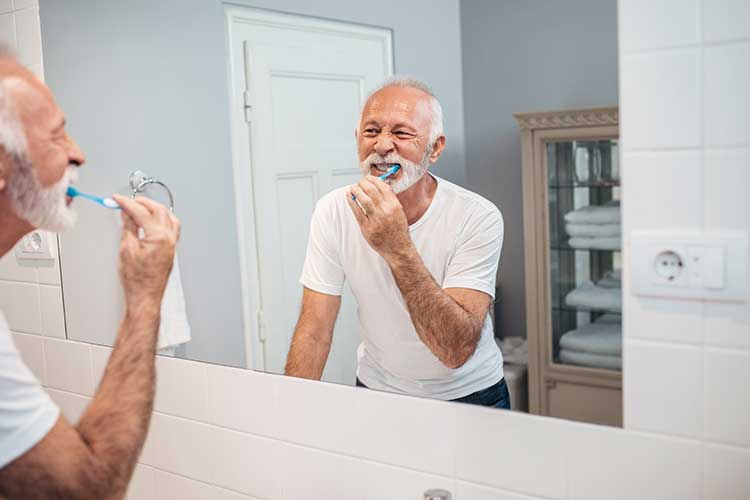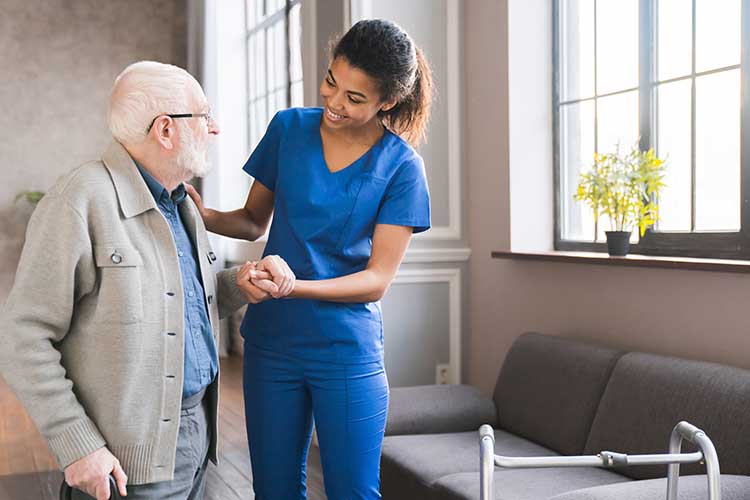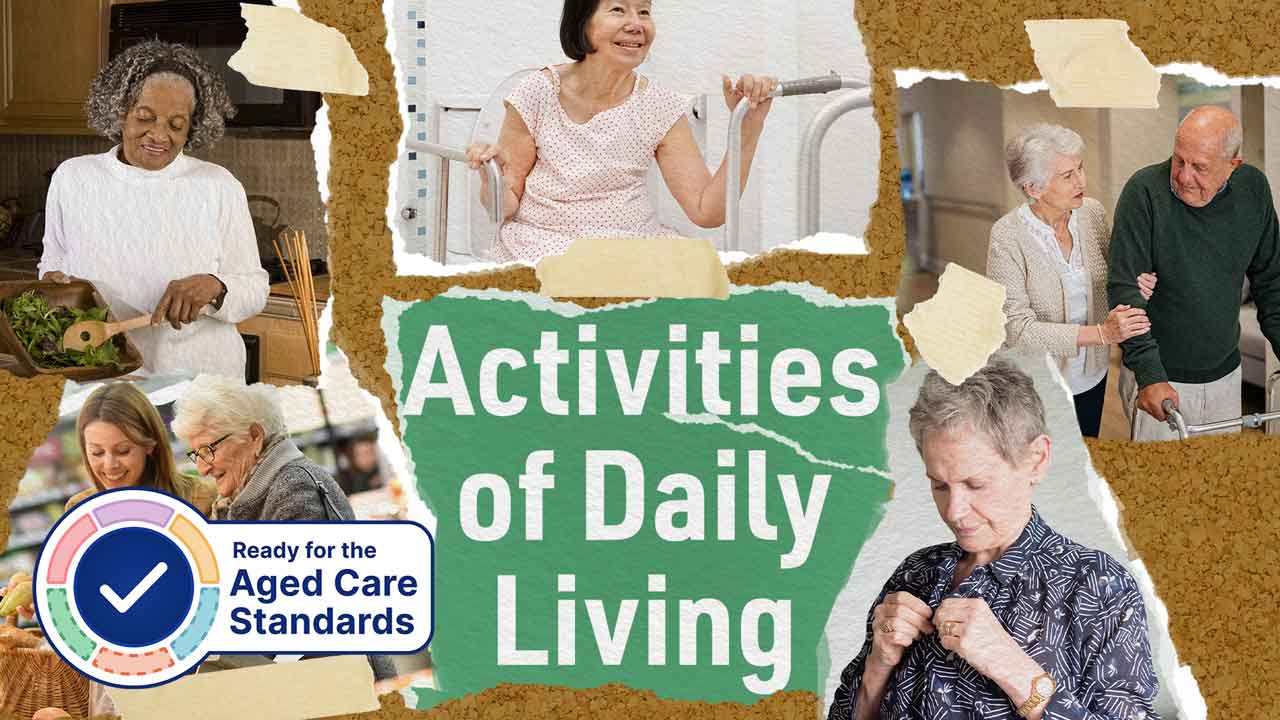In your work, you may need to assist clients with activities of daily living (ADLs). These are basic, essential tasks that are part of every person’s daily life, and therefore, it’s important that you understand what ADLs are, as well as their clinical significance.
What are Activities of Daily Living (ADLs)?
The term activities of daily living (ADLs), which was created by Sidney Katz in 1950, refers to the fundamental life skills that someone must be able to perform in order to independently care for themselves.
Being able to perform ADLs is an indicator of functional status. Someone who struggles with ADLs is likely to experience a poorer quality of life, depend more on other people and mobility devices, and live with a risk of harm if not properly cared for (Edemekong et al. 2023).
ADLs are typically used to measure the functional abilities of older adults, people living with disability, and those who have undergone surgery (Physiopedia 2021). They may assist in determining whether someone requires extra support, for example, home care or admission to an assisted living facility (Edemekong et al. 2023).
Types of Activities of Daily Living
Basic Activities of Daily Living
Basic ADLs (also known as BADLs) include:
- Ambulating - the ability to move from one position to another and walk independently (e.g. going from a sitting to a standing position, moving from a bed to a chair)
- Feeding - The ability to independently feed oneself
- Dressing - The ability to choose and put on appropriate clothes
- Personal hygiene - The ability to bathe, groom oneself, maintain dental hygiene and perform nail and hair care
- Continence - The ability to control bladder and bowel function
- Toileting - The ability to get to and from the toilet, use the toilet appropriately and clean oneself after using the toilet.
(Edemekong et al. 2023; Physiopedia 2021)

Instrumental Activities of Daily Living
Instrumental ADLs (IADLs) are more complex tasks that are required in order to live in the community independently. They generally require greater thinking skills, including organisational skills (Edemekong et al. 2023).
IADLs include:
- Transportation and shopping - The ability to buy necessities, attend events and organise a means of transportation
- Managing finances - The ability to pay bills and manage financial assets
- Meal preparation - The ability to get a meal on the table, including shopping for groceries and storing them in the home
- Home maintenance - The ability to perform housework and maintain the home (e.g., cleaning, keeping living areas tidy, doing laundry)
- Managing communication with others - The ability to manage the household’s phone and mail, and ensure the home is welcoming for visitors
- Managing medications - The ability to get prescriptions filled, keep medicines up-to-date and take them as directed (e.g. taking them on time and at the right dosage)
- Coordinating healthcare
- Social interaction
- Community interaction - The ability to participate in services, events, hobbies and spiritual observance
- Responsibilities for others - The ability to perform tasks such as parenting and carer roles
- Safety procedures and emergency responses
- Decision-making.
(Edemekong et al. 2023; ME/CFS SA 2021)
Activities of Daily Living Under the Strengthened Aged Care Quality Standards
Standard 3: Care and Services - Outcome 3.1: Assessment and Planning under the strengthened Aged Care Quality Standards (Action 3.1.5) requires older people’s care and services plans to be reviewed when there is a change or deterioration in their ability to perform activities of daily living (ACQSC 2024).
Furthermore, Outcome 3.2: Delivery of care and services (Action 3.2.5) requires aged care workers to be supported to recognise these changes (ACQSC 2024).
What Affects the Ability to Perform Activities of Daily Living?
Someone might become unable to perform ADLs due to:
- Physiological changes associated with ageing
- Decreased physical capacity caused by musculoskeletal, neurological, circulatory or sensory conditions
- Cognitive or mental impairment (e.g. dementia)
- Social isolation
- Medication side effects
- An unsuitable home environment
- Episodes of acute illness
- Admission to hospital.
(Edemekong et al. 2023)
Measuring Activities of Daily Living
Measuring a person’s capacity to perform ADLs is a routine assessment that provides insight into whether the individual requires more support in their day-to-day life. The inability to perform ADLs may lead to serious harm, for example, a person who has difficulty mobilising will be at greater risk of falling (Edemekong et al. 2023).
There are a variety of tools that can be used to assess a person’s ADLs. One such tool used in Australia is the Resource Utilisation Groups - Activities of Daily Living (RUG-ADL), which measures four ADLs: bed mobility, toileting, transfer and eating (DoH 2021).
Clients are assessed in these four categories and assigned a score between 1 and 5 for each, with a score of 1 indicating that the client can perform the task independently or with supervision only, and a score of 5 indicating that the client requires two or more people to physically assist them in order to perform the task (DoH 2021).
Note: Not every category uses every score.
| ADL | Capacity | Score | Definition |
|---|---|---|---|
Bed mobility - The ability to move in bed after the transfer into bed has been completed. |
Independent or supervision only | 1 |
|
| Limited physical assistance | 3 |
|
|
| Other than two persons physical assist | 4 |
|
|
| Two or more persons physical assist | 5 |
|
|
Toileting - The ability to mobilise to the toilet, adjust clothing before and after toileting, and maintain perineal hygiene without incontinence or soiling clothes. Note: If the client requires different levels of assistance for urination and defecation, record the lower performance of the two. |
Independent or supervision only | 1 |
|
| Limited physical assistance | 3 |
|
|
| Other than two persons physical assist | 4 |
|
|
| Two or more persons physical assist | 5 |
|
|
Transfer - the ability to transfer in and out of bed, bed to chair, in and out of shower/tub. Note: The score should be based on the lowest performance of the day/night. |
Independent or supervision only | 1 |
|
| Limited physical assistance | 3 |
|
|
| Other than two persons physical assist | 4 |
|
|
| Two or more persons physical assist | 5 |
|
|
Eating - The ability to cut food, bring food to the mouth, chew food and swallow. Note: Does not include meal preparation. |
Independent or supervision only | 1 |
|
| Limited assistance | 2 |
|
|
| Extensive assistance/total dependence/tube fed | 3 |
|
(Adapted from Williams et al., as cited in DoH 2021)
The four scores will then be added together, resulting in a total of between 4 and 18. The higher the total score, the more support the client requires in order to perform these ADLs.
Assisting With Activities of Daily Living

When assisting clients with ADLs, remember that your goals are different to theirs. What might be a work task to you is another person’s daily routine and life. For example, while you might be rushing to transfer a client from their bed to a chair because you know you have other clients to attend to, the client might just want to watch television without being disturbed (ATrain Education 2017).
It’s also important to understand that in Western societies, where independent living is encouraged, being unable to perform ADLs may cause feelings of fear and distress due to the associated loss of autonomy (Edemekong et al. 2023).
When assisting clients with ADLs:
- Allow the client to express their wishes and respect their autonomy (e.g. accept that a client might not want to do a particular task)
- Make eye contact
- Use a calm demeanour and voice
- Offer choices (e.g. ‘Would you like apple juice or orange juice?’)
- Be empathetic
- Give the client adequate personal space and avoid crowding them
- Use non-challenging body language
- Allow plenty of time to assist the client with the ADL
- Give the client clear, simple instructions.
(ATrain Education 2017)
Test Your Knowledge
Question 1 of 3
Finish the sentence. Medication management is …
Topics
Further your knowledge




References
- Aged Care Quality and Safety Commission 2024, Standard 3: Care and Services, Australian Government, viewed 29 April 2024, https://www.health.gov.au/resources/publications/strengthened-aged-care-quality-standards-august-2025?language=en
- ATrain Education 2017, 8. Assistance with Activities of Daily Living (ADLs), ATrain Education, viewed 29 April 2024, https://www.atrainceu.com/content/8-assistance-activities-daily-living-adls
- Department of Health 2021, AN-ACC Reference Manual, Australian Government, viewed 29 April 2024, https://www.health.gov.au/resources/publications/an-acc-reference-manual-and-an-acc-assessment-tool?language=en
- Edemekong, PF, Bomgaars, DL, Sukumaran, S & Schoo, C 2023, ‘Activities of Daily Living’, StatPearls, viewed 29 April 2024, https://www.ncbi.nlm.nih.gov/books/NBK470404/
- ME/CFS South Australia 2021, Activities of Daily Living (ADLs), ME/CFS SA, viewed 29 April 2024, https://mecfssa.org.au/resources/activities-of-daily-living-adls
- Physiopedia 2021, Activities of Daily Living, Physiopedia, viewed 29 April 2024, https://www.physio-pedia.com/ADLs
 New
New 
